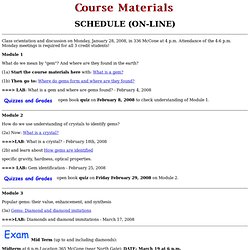

Sites et boutiques en ligne officiels de Cartier - Le célèbre joaillier et horloger de luxe français. Mariage, accessoires de luxe, parfums et cadeaux exceptionnels. UC Berkeley EPS2: What is a gem? EPS2 Introduction. EPS2 Introduction. Color Filters - The Gemology Project: A Gemologist & Gemstone Database. Color filters have many uses in gemology. The Chelsea Colour Filter™ (CF) is the most prominent of them. While the CF is the most used, other filters can serve for a variety of applications. Among those are diffused colored plates used in conjunction with a microscope to inspect sapphires, narrow bandwidth filters to determine dispersion, and blue, red or yellow filters to examine fluorescence in gemstones. Some people regard the CF as a primary tool, yet all modern gemology writers disagree with that statement. It can, however, give clues to the identity of a gemstone when used as an additional (secondary) tool. Most color filters show their real power when inspecting parcels of gemstones.
Basic All color filters work on the same principle: they absorb certain wavelengths of light, letting only a portion of the visible part of the electromagnetic spectrum pass through. Proper use of colored filters Chelsea Colour Filter™ However, it proved to be useful in other circumstances. SYLLABUS. Class orientation and discussion on Monday, January 28, 2008, in 336 McCone at 4 p.m.

Attendance of the 4-6 p.m. Monday meetings is required for all 3 credit students! Module 1 What do we mean by "gem"? And where are they found in the earth? (1a) Start the course materials here with: What is a gem? (1b) Then go to: Where do gems form and where are they found? ===> LAB: What is a gem and where are gems found? Open book quiz on February 8, 2008 to check understanding of Module 1. Module 2 How do we use understanding of crystals to identify gems? (2a) Now: What is a crystal? ===>LAB: What is a crystal? (2b) and learn about How gems are identified specific gravity, hardness, optical properties. ===> LAB: Gem identification - February 25, 2008 open book quiz on Friday February 29, 2008 on Module 2. Module 3 Popular gems: their value, enhancement, and synthesis. Stones,Jewelry,Gifts-Reference Database. OPTICS-MART items - Get great deals on Gem Cloth, Slide Lock Diamond Tweezers, Brand New items on eBay Stores!
MODERN GEM GEMOLOGY - HOW GEMS ARE IDENTIFIED. By Don Clark IMG CSM One of the biggest challenges for the gemologist is, not just obtaining accurate data, but properly analyzing it.

After making some initial tests, they begin looking at long lists of potential species. It is easy to loose your way in a sea of data and important clues are often overlooked. New Procedures With the advent of Gemology Tools, searching data has become much easier and errors are minimized. As nice as this is, that is just the icing on the cake. Traditional gemology teaches that when examining an unknown gem, the two most useful pieces of information are the refractive index and the specific gravity. Gemology Tools allows you to search by visual properties as well as measured data. Testing Procedures Step 1, Clean the Gem The first step in any identification is to clean the gem thoroughly. Step 2, Examine with Loupe Next, examine the stone with a loupe and an over head lamp. Examine the stone from every direction, constantly holding the stone under the light. About SG. What is specific gravity?

It is the density of a substance relative to water. As an example, when we say that the specific gravity of quartz is 2.65, we mean the weight of quartz is 2.65 times that of an equal volume of water. Their are a number of ways to write the equation for the specific gravity (SG) of a mineral. Here is the most common: Weight of Mineral in Air SG = ------------------------------------------------------------------------------ Weight of Mineral in Air - Weight of Mineral in Water So from this equation, you need only first weigh the mineral in air (which means the same as "weighing it"), then suspend the mineral in water for the second weighing. A Study of Specific Gravity. Understanding Specific Gravity Here's one of my favorite demonstrations that is fun for everyone...and good for gemologists and jewelers.

Its a rather simple but graphic demonstration of how the density of a medium will affect the weight of another medium. Which is why a 1.00 carat sapphire is actually smaller than a 1.00 carat diamond. Because a sapphire is more dense than a diamond. Which means that a diamond and sapphire of the same size will weigh differently. To understand this demonstration we need to first see what it happening. Now, let's assume that you have three gemstones of the same millimeter size. We can use this principle to determine the specific gravity of a gemstone by reversing the process. Now, lets see a specific example of how this works in gemology.
Next we will drop the amber into the clear water and see what happens: Gemology, Gem Rough,Gemology,Gem Identification Tools,Facet Rough - PrettyRock.com. Gems and Precious Stones. Copyright 2002: Jill Banfield and Hanna Cook-Wallace: Instructor: Jill Banfield.

What is a Crystal?